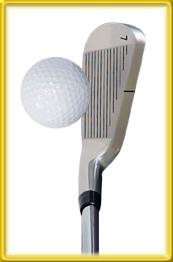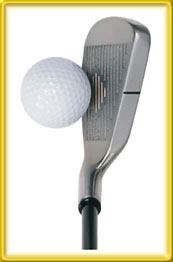If you’re trying to decide whether to purchase traditional, blade-style irons or game-improvement irons, here’s a breakdown of each type’s features, pros and cons:
Blades
- Clean, classic appearance with thin top line and chrome finish
- Superior feel on well-struck shots
- Allow skilled golfers to easily shape shots (draws and fades)
- Relatively high center of gravity (CG) produces penetrating ball flight; effective in windy conditions
- Feedback on poorly struck shots can help diagnose swing flaws
- Small heads can be intimidating to average and novice golfers
- Less forgiveness on off-center hits, which may lose considerable distance and accuracy
- Higher CG makes it more difficult to get sufficient height on shots with longer irons (3-5)
- Larger head size instills confidence in achieving solid contact
- Perimeter weighting creates larger effective hitting area, minimizing loss of distance and accuracy on mishits (i.e. more forgiveness)
- Usually feature offset, which reduces pushed and sliced shots and makes it easier to turn the ball right to left (for right-handers)
- Low CG produces higher ball flight, improves chances of getting good loft on longer iron shots
- Skilled players often prefer look and feel of forged blades
- More difficult to shape the ball due to clubs’ shot-straightening qualities
- Provide less feedback on off-center hits, disguising the causes and effects of poor swings
- Low CG can make ball “balloon” in windy conditions, reducing control
Cons:
Game-improvement irons
Cons:
Of course, there are irons that combine the best of blade and game-improvement designs.
Thomas Golf’s (For more information on Thomas Golf Irons:) offerings include custom-fitted, cavity-back irons with compact clubheads.
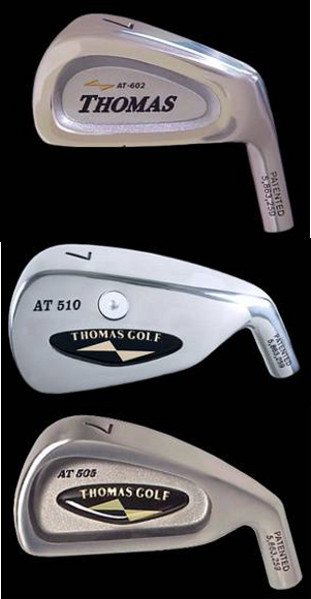
What Are Game Improvement Irons?
If you have never hit an old forged iron before, consider yourself on a mission. The only way to re-create an off center hit with an old iron is to hit balls with your own clubs when it’s about 28 degrees outside. Even then you still don’t capture the entire experience. It’s difficult to appreciate what is offered from today’s golf club manufacturers unless you step back to the time there was no mass manufacturing of game improvement clubs.
There was a need for game improvement irons in the 60’s and 70’s as golf was making an impression on people who had never played golf before. Golf on television was prevalent and tour professionals were known by their first names. For the first time in history the PGA Tours sister organization, the PGA of America was doing their best to grow the business of golf and attract players from a larger demographic than just the wealthy. With a mutual interest in growing the game were the club manufacturers who needed to find a way to sell more irons and now had the perfect new audience to cater to. Once it was discovered how to mass manufacture irons that actually helped golfers, golf technology was propelled into a new chapter of evolution and golf clubs have never been the same.
The first sets of game improvement irons concentrated on not penalizing golfers as much for off-center hits. The meat and potatoes of the golfing demographics are those with handicaps of 27 and over. The amount of times an average golfer will hit the center of the club face far outweighs the amount of center face shots they will make. It’s bad enough to hit a poor shot but to have your hands vibrate like you just hit a rock adds insult to the ego. If it doesn’t feel good then it isn’t good.
Game improvement club manufacturers have the ability to move the weight in the club head around in creative ways. When weight is moved away from the center of the club face and redistributed further back from the face or to the heel and toe the amount the club will twist is less. In many game improvement irons this means that the loss of distance in an off-center shot will be just a few yards.
In addition the club twists less allowing off center hits to stay on-line better. In some cases the club helps the ball get back on line and eliminates some side spin.
Another improvement is the lowering of the weight in the club face. Loft is a friend of the amateur golfer because it negates side spin. The lower weight allows the actual loft of the irons to be bumped down and help increase distance. That is why so many irons are strong lofted, about a full club or club and a half more than clubs 25 years ago. Lighter, more forgiving and strong-lofted clubs are what today’s largest group of golfers look for in irons.
With a blend of technology ranging from physics to chemistry golf club manufactures continue to tinker with designs that are both attractive and effective. To ask today What are game improvement Irons and then to ask the same question 5 years from now will give you very different answers. While the game improvement clubs of the 60’s and 70’s had larger and thicker heads today you can find forgiving clubs with traditional looks. There are many things that have helped revolutionize golf but game improvement irons are near the top of that esteemed list.
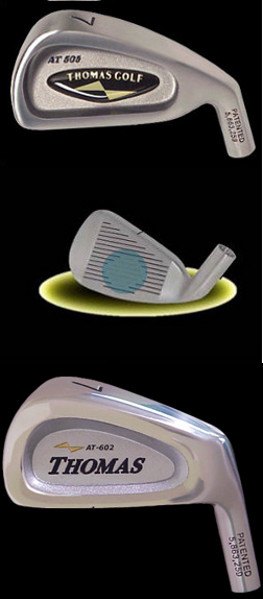
Game Improvement Irons vs Players Irons
There used to be no fine line between players irons and game improvement irons. Players irons were small and sharp looking, shiny and shots felt soft off the face (if you hit them in the sweet spot.) Game improvement irons were large and clunky but easier to hit.
Both types of club have improved so much that it’s at times difficult to tell the difference between them. Players clubs now offer wider top lines and larger heads. The have carbons and metals blended with them that allow more forgiveness than their predecessors. Game improvement clubs have become sleeker as they retain the original characteristics that made them popular, with the main one being improving off-center shots. There seems to be a club to fit everyone and part of the fun of buying new irons is searching for the perfect set for you. If you crave the feel of players irons but aren’t quite skilled enough to hit the center of the clubface every time there are options for you. You can find clubs that still look sleek and shiny but also redistribute the weighting of the clubhead so that off-center shots will not lose as much distance as past players clubs. Players clubs have a thinner top line that makes the club inviting for the better player and those who love the conventional looks. The heads are a little smaller than game improvement irons which gives the appearance of that the player has more control over the clubface.
In a way they seem to be easier to hit than the larger heads of the game improvement irons because it’s easier to feel whether you hit the ball in the center of the clubface or not.
Another characteristic that might attract a player who loves the conventional look of players irons but is not an exceptional player is the use of graphite shafts in players irons. Graphite will give the player more feedback than steel shafts and the graphite is lighter than steel. It was unheard of in years past to put graphite shafts in players irons but now you can buy them off of the shelf. Game improvement irons have also come a long way reaching into the market that was reserved as players irons. Because technology allows weight to be redistributed around the clubhead manufacturers can still make game improvement clubs that have smaller heads. Once molded they can be finished with chrome and come out looking like a players club, especially when the player stands over a shot.
Game improvement clubs will always have an advantage over players irons in improving off center shots. The weight can be distributed so much easier in game improvement irons.
The original game improvement irons simply cut the weight from behind the center of
the face leaving a cavity back. Once the weight was taken away from behind the center of the club the weight leftover around the cavity was in effect stretching the size of the sweet spot and helping the club resist twisting on off center shots. The result was less distance loss on shots not hit on the sweet spot.
Today weight distribution on clubs can help a golfer cure a slice, hit the ball higher or lower and also aid in the feeling that the heads are more controllable. Game improvement irons will continue to improve simply because manufacturers need to sell more golf clubs. Therefore the need for technology will only increase benefitting clubhead designs and of course, golfers. Don’t dismiss the future of players irons though. The technology that makes game improvement irons better will only help the development of players irons. When comparing game improvement irons vs. players irons consider all of the options given and most importantly, try the clubs first.
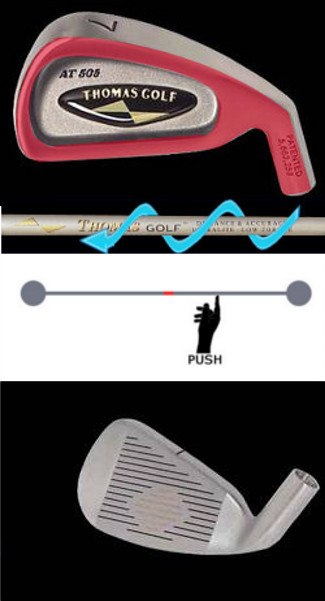
A Shopping Guide for Game Improvement Irons
If you are shopping for a new set of irons it might be good to familiarize yourself with some golf club jargon. Here are some key terms you will come across during your research of game improvement irons. Enjoy your experience and remember, it’s always a good idea to get fitted for your set or at least try the clubs out or before you buy them!
- Club Face- The club face is the surface side of the club on which you hit the golf ball.
- Sweet Spot- The sweet spot is a variable position that is the preferable place to hit the ball on the clubface. Placement is contingent on the size and shape of the clubhead and the weight distribution.
- Top Line- The very top of the clubhead at address position is the top line. The top line is thicker on game improvement irons and thinner on blades and player’s irons.
- Sole Width- The sole is the bottom of the clubhead. The sole width, front to back, is usually wider on game improvement irons and thinner on blades or player’s irons. A wide sole can help prevent the club from digging and with the added weight can promote a higher launch angle.
- Weight Distribution- If you have a rectangle of steel in your hand the center or sweet spot is right in the middle of the rectangle. If you cut out a circle where the sweet spot is and distribute pieces of the circle to other places on the rectangle that is re-distributing the weight. This is an important concept in the formation of game improvement irons because it can reduce the twisting of the clubhead at impact and influence the trajectory of the shot.
- Perimeter or Heel to Toe Weighting- Taking weight from the center of the clubface and redistributing the weight in the heel and toe of the club. By placing more weight on the perimeter of the club it will help it resist twisting on off-center hits.
- Cavity Back- The back of the clubhead looks hollowed out. A cavity back clubhead allows for perimeter weighting.
- Loss of Distance- One way a player can lose distance is by hitting the ball on the face any place other than the sweet spot. Game improvement clubs lessen the distance loss on off-center hits.
- Forgiveness- Forgiveness is when you hit a shot away from the center of the clubface and are not penalized for loss of distance as much if you were hitting blades or player’s clubs.
- Off-Set- Off-set clubheads sit backwards slightly from the center shaft line. The idea is to give the clubhead a little bit more time to close before impact.
- Launch Angle- The trajectory angle immediately after impact. Game improvement clubs will typically have high launch angles.
- Center of Gravity- If the club is weighted so that the vertical distribution of weight is more near the top of the clubface, the ball will fly lower. Whereas when the weight distribution is low in relation to the clubface the ball will fly higher. Game improvement irons on average have a lower center of gravity.
- Oversized Head- Center of gravity is higher helping players who hit the ball too high get more distance by creating a lower trajectory.
- MOI- Moment of Inertia – The moment of inertia is the resistance to twisting by the club head on off-center shots. Game improvement irons on average have a high MOI because of their weight distribution away from the center of the clubface.
- Torque- Clubface Depending on the weight distribution the club will twist, or torque a little or a lot on off center hits. Perimeter weighted and over-sized clubheads usually twist less.
- Strong lofted irons- An aspect of game improvement clubs where the clubs lofts are stronger with the idea that it will increase distance on shots.
- Blades or Muscleback Irons- The topline of these clubs is usually thinner and the clubhead itself is normally smaller. They are more appealing to better players because the smaller size gives the impression of controlling the clubface more easily.
- Mixed Set of Irons- A mixed set is comprised of game improvement clubs and blades or hybrids and conventional looking irons.
- Forged Clubs- Clubheads that are made of softer metals and then finished by hand. They typically have a chrome finish and the faces are smaller than game improvement clubs. The soft feel is appealing to players who are proficient at hitting the ball in the center of the clubface.
- Cast Clubs- Mass manufacturing of machine-made golf club heads. The materials are harder and tougher than forged clubs.
- Torque-Shaft If the shaft twists at impact it will have a smaller, but similar effect as the club twisting. Twisting produces off-line shots.
- Shaft Flex- The shaft flex will help you match the shaft and club up at impact. If a shaft is too flexible then the clubhead trails too far behind the shaft. If it is too stiff the clubhead doesn’t flex enough and your clubhead will have a difficult time closing. The most important aspect of the shaft flex is that it match your swing and swing speed.
- Shaft Kick point- The majority of the weight in the shaft is located either towards the grip (high), in the middle of the shaft (mid) or down where the clubhead is (low.) By and large game improvement irons have a mid to low kick point and promote a higher shot trajectory.
- Shaft Weight- The amount of grams the shaft weighs. A heavier shaft is normally better for advanced players while lighter shafts generally are better for average players. The shaft that is standard in game improvement clubs is matched to the clubhead weight and performance so think twice about an upgrade shaft.
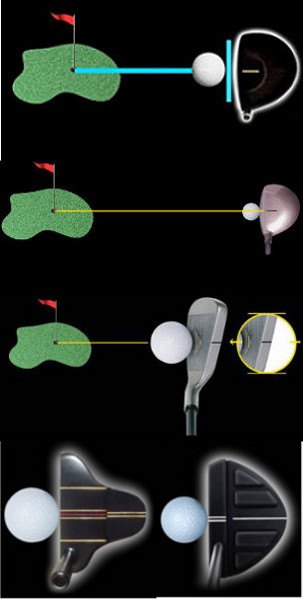
Game Improvement Clubs
There are an enormous amount of options when it comes to golf clubs but the majority of equipment sold is for game improvement purposed. Researchers have taken account of how often average players practice and go on the golf course. They take into consideration the athletic ability of an average golfer and also what their swing specs might be. Those playing a couple times of month are typically a little stiff and swing the club slower. Because they usually don’t practice, the average golfer won’t hit the center of the club face very often. And because the game of golf begs for the retention of their players, game improvement clubs serve a specific interest. How do you make the game more fun? The name game improvement itself implies that the clubs are easy to hit. What they really do is minimize effects of hitting the ball away from the center of the club face. They don’t rob the player of as much distance and help the ball stay in play even if you don’t hit a great shot. They aren’t intimidating to look at and actually can instill confidence in the player who is on the course infrequently. They won’t swing the golf club for you but if you can hit the ball somewhere on the club face they can help you.
As a better player you might think it’s beneath you to play game improvement clubs, but who doesn’t want forgiveness when they hit a bad shot? Research by golf club manufacturers over the past 50 years has helped produce clubs that are lighter and easier to swing. Club heads can be bigger or smaller in size and wider or thinner at the top line of the club. What manufactures have tried to do is make clubs that have the same basic concept in adding distance and minimizing off center shots while designing many different styles so that they can attract golfers of all abilities. Because the largest share of the golf club market is game improvement clubs, there is no reason your entire bag can’t be made up of them. Drivers today are primarily game improvement clubs. The heads are big which means that the weight can be distributed widely. The shafts are light, which means better control of the club and faster swing speed. The materials are made to maximize the effect of transfer of energy from the club to the ball. Additionally, many game improvement drivers are adjustable. The theory is that if you want to play better without changing how you swing you can change the club instead.
Hybrids are a great alternative to temperamental long irons and even mid irons. They look like a wood head and are small and maneuverable. They are very forgiving having more room than irons to move the weight away from the center of the clubface so shots get airborne faster. The added shaft length relative to irons will help add yardage to hybrid shots as compared to an iron of similar loft. There are plenty of game improvement clubs in the market, but whose games will really improve by using them? The obvious answer is everyone, but not everyone wants a set of game improvement irons. However, I bet if you look into the bags of the best players at your golf course you will find at least one game improvement club besides the driver.
Don’t get caught up in tradition so much that you don’t take advantage of game improvement clubs. Look through your bag and note any traditional clubs that might be giving you problems. It’s a good bet that you can find a game improvement club to replace them.

Game improvement Blade Irons
Blade irons appear in the bags of many professionals, top amateurs and those golfers who live for the traditional look and feel of real steel. Even though standard game improvement irons have been around for about 50 years, there is still a demographic of golfers that prefer the attractive and traditional blade irons. Now many of the blade irons have game improvement characteristics and are marketed to all golfers.
Originally iron heads were shaped by hand and there were often irregularities between irons in a set. Today’s blades are only finished by hand. But because blades are partially hand-made, the weight distribution is normally behind the center of the club which limits distance on shots not hit in the sweet spot.
While the original blade irons were clunky looking, newer soft metal irons are appealing to golfers with their clean outlines, chrome finishes and thin top lines. As an average golfer improves it’s only natural to begin looking for new irons. He or she starts paying more attention to clubs and club designs. Blades are remarkable looking clubs compared to the major game improvement irons. It is much like comparing mini-vans and Mustangs; they each serve their purposes but oh wouldn’t it be nice if you had the functionality of a mini-van in a Mustang body!
In the modern era of blade irons you will see some of their original characteristics but with the added benefit of better weight distribution. Originally blade irons gave very negative feedback to its user if not hit in the center of the clubface. The reason was because of the weight distribution. The irons had no specific area that was designated for weight distribution so it appeared at the center of the face, much like if you were balancing a tongue depressor on your finger.
Because there was nothing substantial to shore up the toe and the heel of the club, every thing rotated around the center of the face. A ball hit on the toe forced the club head to twist back all the way to the end of the toe. Average golfers were familiar with the vibrations an off-center shot produced and the feedback was clear; they didn’t hit a good shot. The only time the club would not twist is when the ball was hit in the center of the face. As the game improvement irons progressed with technology the blade irons trailed behind closely using concepts with weight distribution as a way to reward its golfers while still delivering the feedback a good player desires. The weight has been moved around the blade faces while maintaining the dignity of the traditional looking iron. The most successful of the newer game improvement blade irons use several different materials besides the soft metal clubhead to help redistribute weight. The materials are layered on top of the steel offering more forgiveness than traditional blades while keeping the integrity of the soft feel for continued workability of shots.
Game improvement blade irons don’t own a large share of golf club sales, but there is a specific group of golfers who play blades and will always play blades. It’s good to have a continued market for them because club manufacturers have come to respect the fact that the look of a golf club plays an important role for golfers in the process of buying clubs. That is why they will continue to look for game forgiving aspects they can apply to traditional blade designs.


